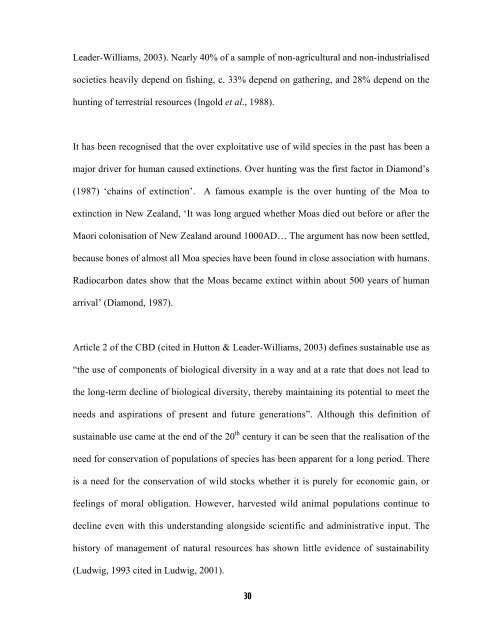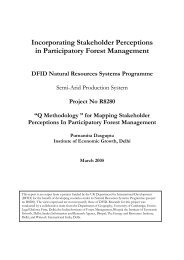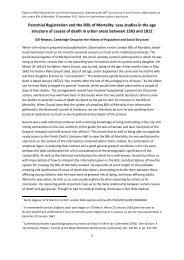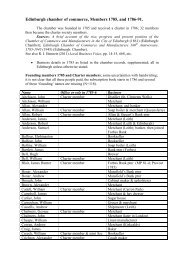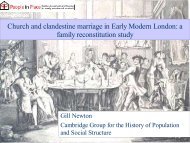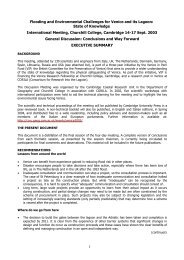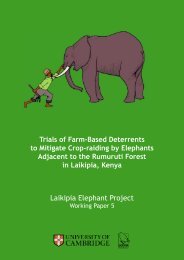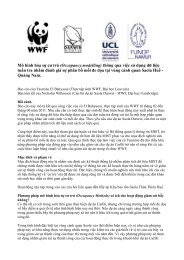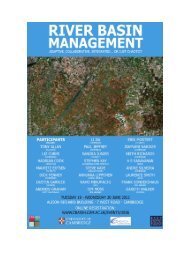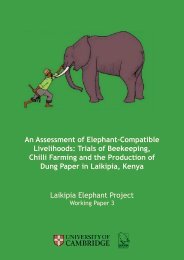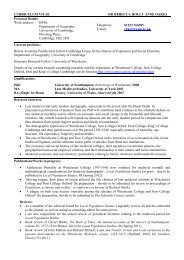Rob Small's Masters Thesis: Uptake and the success of insect ...
Rob Small's Masters Thesis: Uptake and the success of insect ...
Rob Small's Masters Thesis: Uptake and the success of insect ...
Create successful ePaper yourself
Turn your PDF publications into a flip-book with our unique Google optimized e-Paper software.
Leader-Williams, 2003). Nearly 40% <strong>of</strong> a sample <strong>of</strong> non-agricultural <strong>and</strong> non-industrialised<br />
societies heavily depend on fishing, c. 33% depend on ga<strong>the</strong>ring, <strong>and</strong> 28% depend on <strong>the</strong><br />
hunting <strong>of</strong> terrestrial resources (Ingold et al., 1988).<br />
It has been recognised that <strong>the</strong> over exploitative use <strong>of</strong> wild species in <strong>the</strong> past has been a<br />
major driver for human caused extinctions. Over hunting was <strong>the</strong> first factor in Diamond’s<br />
(1987) ‘chains <strong>of</strong> extinction’. A famous example is <strong>the</strong> over hunting <strong>of</strong> <strong>the</strong> Moa to<br />
extinction in New Zeal<strong>and</strong>, ‘It was long argued whe<strong>the</strong>r Moas died out before or after <strong>the</strong><br />
Maori colonisation <strong>of</strong> New Zeal<strong>and</strong> around 1000AD… The argument has now been settled,<br />
because bones <strong>of</strong> almost all Moa species have been found in close association with humans.<br />
Radiocarbon dates show that <strong>the</strong> Moas became extinct within about 500 years <strong>of</strong> human<br />
arrival’ (Diamond, 1987).<br />
Article 2 <strong>of</strong> <strong>the</strong> CBD (cited in Hutton & Leader-Williams, 2003) defines sustainable use as<br />
“<strong>the</strong> use <strong>of</strong> components <strong>of</strong> biological diversity in a way <strong>and</strong> at a rate that does not lead to<br />
<strong>the</strong> long-term decline <strong>of</strong> biological diversity, <strong>the</strong>reby maintaining its potential to meet <strong>the</strong><br />
needs <strong>and</strong> aspirations <strong>of</strong> present <strong>and</strong> future generations”. Although this definition <strong>of</strong><br />
sustainable use came at <strong>the</strong> end <strong>of</strong> <strong>the</strong> 20 th century it can be seen that <strong>the</strong> realisation <strong>of</strong> <strong>the</strong><br />
need for conservation <strong>of</strong> populations <strong>of</strong> species has been apparent for a long period. There<br />
is a need for <strong>the</strong> conservation <strong>of</strong> wild stocks whe<strong>the</strong>r it is purely for economic gain, or<br />
feelings <strong>of</strong> moral obligation. However, harvested wild animal populations continue to<br />
decline even with this underst<strong>and</strong>ing alongside scientific <strong>and</strong> administrative input. The<br />
history <strong>of</strong> management <strong>of</strong> natural resources has shown little evidence <strong>of</strong> sustainability<br />
(Ludwig, 1993 cited in Ludwig, 2001).<br />
30


